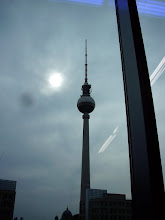The Teufelsberg (German for Devil's Mountain) is a hill in former West Berlin. It rises about 80 meters above the surrounding Brandenburg plain, more precisely the north of Berlin's Grunewald forest. It is an artificial hill with a curious history: it was built by the Allies after the Second World War from the rubble of Berlin during the following twenty years as the city was rebuilt. One estimate for the amount of rubble is about 12 million cubic meters, or about 400,000 buildings. It is higher than the highest natural hill (the Kreuzberg) in the Berlin area. Teufelsberg's origin does not in itself make Teufelsberg unique, as there are many similar man-made rubble mounds in Germany and other war-torn cities of Europe. The curiousness begins with what is buried underneath the hill: a Nazi military-technical college designed by Albert Speer. The Allies tried using explosives to demolish the school, but it was so sturdy that covering it with debris turned out to be easier. In the 1960s a small skiing center was built on the slopes of the hill. The US National Security Agency (NSA) built one of its largest listening stations on top of the hill, rumoured to be part of the global ECHELON intelligence gathering network. The hill was located in the British sector. Mobile Allied listening units would drive to different locales in West Berlin hoping to gain the best vantage point for listening to Soviet and East German military traffic. One such unit drove to the top of Teufelsberg and discovered a marked improvement in listening ability. This discovery eventually led to a large structure being built atop the hill, which would come to be run by the NSA. At the request of US government, the ski lifts were removed because they allegedly disturbed the signals. The station continued to operate until the fall of East Germany and the Berlin Wall, but after that the station was closed and the equipment removed. The buildings and radar domes still remain in place. During the NSA Operations some other curious things happened: It was noticed that during certain times the reception of the radio signals was better than during the rest of the year. The 'culprit' was found after a while: it was the Ferris wheel of the annual German-American Festival on the Hüttenweg in Zehlendorf. From then on, the Ferris wheel was left standing for some time after the festival was over. There were also rumors that the Americans had excavated a shaft down into the ruins beneath, but that could never be proven. One theory states that it was an underground escape tunnel. In the 1990s, as Berlin experienced an economic boom after German reunification, a group of investors bought the former listening station area from the City of Berlin with the intention to build hotels and apartments. There was talk of preserving the listening station as a spy museum. Berlin's building boom produced a glut of buildings, however, and the Teufelsberg project became unprofitable. The construction project was then aborted. As of the early 2000s, there has been talk of the city buying back the hill. However, this is unlikely, as the area is encumbered with a mortgage of nearly 50 million dollars. Recently the site has been vandalized heavily since the company abandoned the project. Following the announcement of plans to raze the facility and reforest the hill, talk of preserving the facility resurfaced in 2009, spearheaded by the Field Station Berlin Veterans Group, which hopes to have the memorial named in honor of Major Arthur D. Nicholson, the last Cold War casualty, the U.S. Military Liaison Mission tour officer who was shot and killed by a Russian sentry near Ludwigslust on March 24, 1985. After no further construction was done after 2004, in 2006 the hilltop was categorized as forest in the land use plan of Berlin, thereby eliminating the possibility of building.
Subscribe to:
Post Comments (Atom)



No comments:
Post a Comment